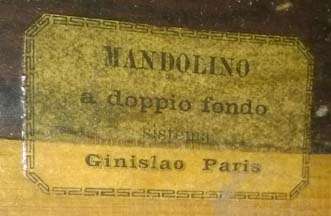Ginislao Paris
| Ginislao Paris | |
|---|---|
 | |
| Born |
March 15, 1852 Naples, Italy |
| Died | unknown, after 1917 |
| Occupation | Trombonist, Mandolinist |
Ginislao Paris (Ginislao Cesare Antonio Paris (Russian:Джинислао Францевич Парис)) (1852 – after 1917) Italian musician (Trombone, Mandolin), mandolin enthusiast, composer and inventor of special mandolin construction type known as “Sistema Ginislao Paris”.[1]
Ginislao Paris was born 15 March 1852 in Montecalvario Quarter of Naples of Francesco Paris and Maria Grazia Violante.[2]
From 1868 to 1872 he served as a volunteer in Italian Military Forces.[3]
From 1 January 1876, Ginislao Paris starts service as a Trombonist in the Orchestra of Russian Imperial Opera in St. Petersburg. (Mariinsky Theatre Orchestra).[4]
In 1879 he married Maria Alexandrovna Strasser in St. Petersburg. They had daughters: Violetta-Tamara (b.1882) and Margherita (b.1893).[5]
In 1880's Ginislao Paris led the Society of Amateur Mandolinists and Guitarists of St. Petersburg (Circolo),[6] which eventually became the first mandolin orchestra in Russia. According to Flaviy Sokolov's book, Vasily Andreyev was inspired by Ginislao Paris orchestra to turn from his solo balalaika performances to creation of a full orchestra of Russian folk instruments.[7]
Carlo Graziani-Walter, noted Italian mandolinist and composer of its time dedicated his rendition of Rimembranze from Gounod’s Faust for mandolin to Ginislao Paris. The dedication says ” All’ Egregio Signor Ginislao Paris, Professore nei Teatri Imperiali, Maestro Direttore del Circolo Mandolinisti di Benificenza a Pietroburgo”[8]
Ginislao Paris along with Pietro Bozzolo (1840-1907), a violin maker, was a member of the Revisionary Commission of the Italian Charitable Society of St. Petersburg. Proceeds from the concerts were given to that charity.
Russian (and later American) ballet dancer Michel Fokine, the great Anna Pavlova's friend and colleague, in his memoirs recalls playing mandolin in Ginislao Paris' ensemble and later joining Andreyev's Russian orchestra on domra before giving up playing on stage in favour of his ballet career.[9]
Ginislao Paris played in the same orchestra with another Italian, flautist Ernesto Köhler, who also played mandolin and in 1866 wrote the first mandolin method book in Russia. (J.H. Zimmermann, 1866) He was probably also involved in Ginislao Paris circolo.
According to Imperial Theatres Director Telyakovski's diaries, together with Riccardo Drigo, Ginislao Paris wrote music to "Son Uslady" (The Dream of Uslada) performed in January 1903.[10]
Ginislao Paris became a Russian Citizen in 1899.[11]
He retired from the Orchestra in 1900 for health reasons and was granted special merits pension by imperial decree.[12]
In 1905, following Ginislao Paris’ order, Roman luthier Luigi Embergher made several mandolin family instruments based on Ginislao Paris' own design, featuring double top and special bracing system. Only four instruments of “Sistema Ginislao Paris” forming the mandolin family quartet are known presently. One is an Embergher Artistico mandolin model No. 8, held in the Theatre Museum of St Petersburg.[13][14] Another is Liuto cantabile (known as the Russian Embergher) of model 5 bis, another mandolin No.5 bis and mandola model 5 bis, held in private collections.[15]
All Petersburg reference book continued to list Ginislao Paris details until 1917. His further whereabouts and death details are unknown.[16]
References
- ↑ Speranski, Victor (2014). The Russian Embergher, pdf, Internet Archive, (1)
- ↑ Archivio di Stato di Napoli, Stato Civili Ginislao Cesare Antonio Paris, Birth, GS Film Number: 1979375 , Digital Folder Number: 004908666 , Image Number: 00918
- ↑ RGIA (Russian State Historical Archive) Service Movements File of Ginislao Paris Fund 497, descr. 5, file 2388
- ↑ S.P. Dyagilev (Editor) (1898) Imperial Theatres Yearbook, Season 1898-1899 Directorate of Imperial Theatres, St Petersburg (90)
- ↑ RGIA (Russian State Historical Archive) Service Movements File of Ginislao Paris Fund 497, descr. 5, file 2388
- ↑ RGALI (Russian State Archive of Literature and Art) Ginislao Paris. Programme of the Concert in the Petrovskiy College Hall Fund 2980 File No.1374
- ↑ Flaviy Sokolov (1962) Vasily Andreyev and his Orchestra, Muzgiz, Leningrad
- ↑ Rimembranze dell' Opera Faust di Ch. Gounod per mandolino di C. Graziani-Walter, gia Maestro Direttore del R. Circolo Mandolinisti Margherita, G. Ricordi & C., Milano
- ↑ Fokine, Michel (Author), Anatole Chujoy (Editor)(1961) Fokine: Memoirs of a Ballet Master, Little, Brown & Co
- ↑ Теляковский В. А. Дневники Директора Императорских театров. 1898—1901 / Под общ. ред. М.Г. Светаевой; подгот. текста С.я. Шихман и М.г. Светаевой; вст. ст. О.М. Фельдмана; коммент. О.М. Фельдмана, М.Г. Светаевой и Н.Э. Звенигородской. Москва. М.: “АРТ”, 1998.
- ↑ RGIA (Russian State Historical Archive) Service Movements File of Ginislao Paris Fund 497, descr. 5, file 2388
- ↑ RGIA (Russian State Historical Archive) Service Movements File of Ginislao Paris Fund 497, descr. 5, file 2388
- ↑ G.I. Blagodatov, K.A. Vertkov (1972) Catalogue of Musical Instruments of The Leningrad Institute of Theatre, Music and Cinematography, Izdatelstvo Muzyka (105)
- ↑ V.V. Koshelev (2014), Plucked Chordophones, Vol. 1. From the Collection of St. Petersburg State Museum of Theatre and Musical Art, ISBN 978-5-91461-024-8
- ↑ Speranski, Victor (2014). The Russian Embergher, pdf, Internet Archive
- ↑ All Petersburg Reference Book, 1917
External links
- Russian Genealogical Forum, Ginislao Paris
- Familysearch.org
- The Russian Embergher
- Luigi Embergher
- Ginislao Paris and the Mandolin History in Russia Blog
- Pietro Bozzolo on amati.com
- Ernesto Kohler's Mandolin Method, 5th Russian Edition (Electronic document from the Russian State Library)
- St.Petersburg State Museum of Theatre and Music
- Итальянское благотворительное общество в С-Петербурге.